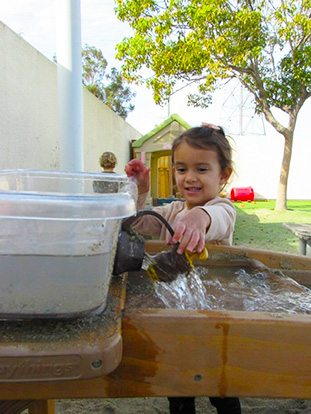
Program Information
Who is the Alexa’s PLAYC preschool program for?
Alexa’s PLAYC is designed for both children with autism spectrum disorders and typically developing children. Our inclusive environment fosters social growth, empathy, and collaboration, allowing all children to thrive together.
What age does my child have to be to enroll in Alexa’s PLAYC?
Alexa’s PLAYC accepts children ages 18 months until they enroll in either kindergarten or transitional kindergarten.
What is an inclusion classroom?
An inclusion classroom is a space where children of all abilities, including those with autism spectrum disorders, learn together with their peers. This environment celebrates neurodiversity and fosters mutual respect, understanding, and growth for every child.
Will my typically developing child benefit from enrollment in an inclusion classroom?
Yes, research indicates that typically developing children in inclusive settings develop stronger communication and leadership skills, gain a deeper understanding of diverse perspectives, and exhibit increased empathy and compassion. This environment fosters mutual respect and understanding, contributing to improved self-esteem and social abilities. Moreover, inclusive classrooms promote positive attitudes towards individuals with disabilities, preparing all students for a diverse society.
Do you offer part-time childcare?
Part-time childcare slots are limited and only available at our Murrieta location for the preschool classroom (ages 3 years old and up). Treatment slots for autistic learners are always half-day.
What are your hours?
- San Diego location: 6:45 am to 5:30 pm.
- Murrieta location: 7:00 am to 5:30 pm.
Is Alexa’s PLAYC closed on holidays?
Alexa’s PLAYC is open year-round and closes only for major holidays and staff development days.
Are meals provided?
Caregivers are responsible for providing lunch for their child. We offer a morning and afternoon snack.
Enrollment & Eligibility
What is the process for enrolling in Alexa’s PLAYC?
To begin the enrollment process for Alexa’s PLAYC, families should add their child to the waitlist by applying through our interest list. When an opening becomes available, children undergo a screening process that typically includes direct assessment, caregiver interviews, and observations in the classroom setting. If any concerns arise during the screening, they will be discussed with the caregiver.
Note: For children under three years old who are showing signs of autism, enrollment must be initiated through the local Regional Center service provider. This process is specific to anyone enrolling their child in the half-day treatment program via the Regional Center.
How long is the waitlist?
The length of the waitlist can vary depending on your child’s age and the time of year. It’s always best to fill out an interest list application as soon as possible to secure a spot and stay informed about availability. We recommend submitting the application early to increase your chances of being placed sooner.
Does Alexa’s PLAYC offer any discounts or accept subsidies?
Yes, we offer several discounts to make our program more accessible. We provide an employee discount for those working at Rady Children’s Health, a sibling discount for families enrolling more than one child, and we accept military and county subsidies to help support eligible families. Please contact us for more information on how to apply for these discounts or subsidies.
What skills are important for an autistic child to benefit from Alexa’s PLAYC program?
Children who benefit most from our program typically show some evidence of joint attention, social motivation, and emerging social communication skills. These factors are crucial for successful treatment planning. Children with significant behavioral concerns or those requiring more individualized support may make better progress in one-to-one services/individual support or therapy.
Can autistic learners attend full-day?
No, children with autism spectrum disorders attend a half-day program, either from 8:30 a.m. to 12:00 p.m. or from 2:00 p.m. to 5:30 p.m.
Is toilet training required?
No, toilet training is not a requirement. Alexa’s PLAYC will support children through the toilet training process when both the caregivers and child are ready.
Are immunizations required?
Yes, children must be up to date on their immunizations. They do not need to provide proof of Covid-19 or flu vaccines.
Staffing Information
What kind of educational background do your teachers have?
Our team at Alexa’s PLAYC includes experienced teachers and behavior technicians, all of whom hold at least a bachelor’s degree in relevant fields. In addition to their formal education, our staff receives ongoing training and supervision from our team of skilled clinicians and our lead teacher to ensure the highest standards of care and education.
Above all, our team shares a deep respect for every child, recognizing their unique strengths and supporting their growth with compassion, understanding, and dedication.
How do you respond to behavior challenges?
We use positive behavior support strategies to help all children develop appropriate behaviors. This includes proactive techniques such as redirection, engagement, and positive reinforcement. When necessary, we work closely with caregivers to create a tailored behavior plan that addresses significant challenges and supports the child’s individual needs. Our approach is focused on building skills, fostering understanding, and promoting a positive, nurturing environment.
What is the teacher-to-child ratio?
San Diego Classrooms:
- Toddler Class (18 months to 3 years): 1 teacher for every 3 children
- Preschool Class (2.5 years to 3.5 years): 1 teacher for every 4 children
- Preschool Class (3.5 years to kindergarten-eligible): 1 teacher for every 7 children
Murrieta Classrooms:
- Toddler Class (18 months to 3 years): 1 teacher for every 3 children
- Preschool Class (3 years to kindergarten-eligible): 1 teacher for every 5 children